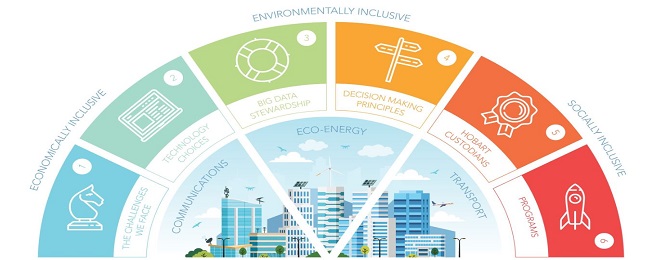The City of Hobart has released an action plan of new technology ideas that could help the council to deliver its City Vision, called Connected Hobart.
The plan lists several ideas in the eight categories that make up the City Vision.
An online survey asks you to rank the ideas in order of which you think is the most important, and also asks for your own ideas for technology that can help achieve the vision’s objectives.
There are a few listed actions designed to make it easier to ride a bicycle or collect the data to provide the city with better information to plan active transport infrastructure, including the below.
Get-Paid-To-Bike Scheme Trial
This is a timely idea seeing Bicycle Network included a similar proposal in our federal election priorities paper.
Countries and cities that have tried this include Belgium, The Netherlands, France and the Italian city of Bari.
Each have their own twist, but the purpose is to provide another incentive for residents to get out of cars and onto bikes when they are heading to and from work.
Technology can make the administration of schemes easier with GPS units attached to bikes measuring distances travelled and times and then sending directly to the bank for reimbursement.
Another method is to provide tax deductions for riders or their employers, technology again can confirm the commutes happened and store that information for the tax office.
Active Travel and Environmental Gamification Trials
Like the payment to ride to work, the gamification trial would provide rewards for choosing sustainable transport options.
Such schemes don’t have to involve direct monetary payments, they can include incentives such as getting your tenth trip free on the bus if you catch it each weekday. Or you may get a free bike service if you ride each weekday for a set period, or a discount at a sports good store for walking each day.
Treating transport choices as a game helps people to think about other options than driving a car and provides an incentive to make different choices.
Reserve Tracks ‘Traffic Light’ Notification Trials
Half of the Hobart council area is bushland, complete with walking and biking tracks and fire trails.
The digital sign on Huon Road that alerts us to closures of the road to the summit of kunanyi/Mt Wellington is the tip of the iceberg of what can be done to make track information more accessible.
The entry and exit points for tracks and trails could have digital signs that notify users of any issues on the track, such as trees down, fire danger and storm danger, track maintenance and closures. Trailheads could be programmed and connected to an app so you can check before you leave home.
Cycle-to-City Bicycle Smart Locker and Membership Trial
End-of-trip secure bike parking, lockers, e-bike chargers and shower/change room facilities are available in other cities at central locations for people whose workplaces don’t have them, or for people coming into the city to shop or access services.
The Cycle2City facility in Brisbane is one such example.
These facilities can be housed in existing car parks or other buildings which have easy access for bicycles and are within the city centre, close to many employers and other attractors like the hospital or university.
A swipe card can be used for access and charging and businesses can be encouraged to set up shop to offer services such as bicycle repairs, bicycle courier warehousing and laundries.
A lesser version of this is secure, swipe card accessed pods/shelters throughout the city that have bike parking and lockers available. A version of these have started up in New York and fit into the size of existing car bays: www.ooneepod.com
Last Mile Micro Mobility and Data Trials
A trial of a scheme that provides access to shared cars, electric scooters and electric bicycles, with vehicles parked in off-street and on-street places.
While such a scheme can help people with their “last mile” trips from public transport or from workplaces to meetings, they can also be useful for inner-city residents living in apartments without car parks.
Share bike schems have failed in Melbourne and Sydney before, but new technology to better manage charging and parking, and the advent of electric bicycles and scooters, may prove more successful.
Connected and Actively Managed Transport Network
Such a system allows for the prioritisation of certain transport modes depending on location. So streets which are deemed active transport routes can ensure pedestrian and bicycle lights stay on for longer and work to their needs rather than being focused on moving vehicle traffic.
There is also “green wave” technology which allows riders on bike paths to ride without stopping thanks to sensors that pick up average speed and rider numbers to turn lights ahead green.
Suburban Electric Vehicle Charging Network
Such a network could utilise existing infrastructure to provide easy charge points for a wide range of electric vehicles, including bicycles. For “lightweight” electric vehicles it may be more convenient to provide charging stations in light poles in suburban streets.


